Mumbai, Maharashtra [India] : Since our ancient times, India has been known as the land of ‘Sujalam and Sufalam’. The various rivers worshiped as deities has ensured that Indians remain water secure. However, rising urban population and growing industrialisation have taken a toll on water resources and rivers once worshipped have turned into sewage canals. This demanded a fresher outlook towards the overall management of the Urban Water Cycle. An integrated approach comprising of Water Supply and Sewage Treatment with Reuse is the only solution to this crisis.
The thumb-rule is 80% of potable water supplied to a city returns as sewage. Our towns generate over 61,000 MLD of sewage with only 30% sewage treatment capacity available in cities and 3% in small towns. This untreated sewage is a hazard to socio-environmental health. Our cities mostly pollute the very water source they depend on with sewage generated. We lack STPs in place and for the ones we have, we do not have suitable maintenance budgets. We release 15,000 Million Litres of Municipal and Industrial Waste into the Ganga everyday.
Nagpur was no different. With a 27-lakh population, consuming 700 MLD of fresh water daily roughly 80% translating to ~550 MLD converted in sewage. A solution to this issue was treating sewage and REUSING it.
Nagpur’s sewage flowed through three rivers cum drains viz. Pivali, Pohra and Nag. This polluted the famous Gosikhurd Dam, a source of fresh water and irrigation. The Hon’ble High Court on a petition ordered action to bridge the gap of sewage generation and treatment. For Nagpur Municipal Corporation, it was financially impossible to meet this requirement and took a PPP route focusing on Reuse of the treated sewage water.
It involved collection of 200 MLD of sewage from rivers and augmenting a 100 MLD STP to 200 MLD with Reuse of treated water as final goal. The project was structured on PPP model with Vishvaraj Environment Pvt. Ltd. selected through a competitive bidding process for 30 years.
Entire project was built though 100% private investment making it the largest and the first STP on PPP model.
The real innovation was Reuse of this sewage treated water by the industry. MAHAGENCO, the state power generation utility agreedto using treated sewage at its two power plants.
Alongside a path-breaking policy by Ministry of Power made it mandatory for power plants across India to use treated sewage water, if available within a 50 km radius. The cost is allowed as a pass-through tariff by power plants making it financially sustainable.
Work on a 200 MLD STP and Reuse phase commenced in June 2018, withMahaGenCogoing to use 190 MLD for its Khaparkheda and Koradi plants. The challenge involved laying a 1,500 mm dia pipeline through dense urban areas and crossing railway lines at six locations. The project was completed 9 months ahead of its designated construction period of two years that too in the peak pandemic situation.
The project proved to be a winner for everyone – municipality got a facility,city got its
future fresh water needs taken care off for 35 years and the power plants secured water supply. Citizens benefittedas sewage is treated and fresh water freed up.
For the remarkable execution of this path-breaking project, Vishvaraj Environment bagged the first prize at the FICCI water award 2020 held virtually on 16 February 2021.
Mr. Arun Lakhani, CMD, Vishvaraj Environment expressed his views on the Reuse philosophy saying, “Water Sustainability is a term which should remind us all, how inadequately we are coping with these subjects. This is slowly becoming critical for humanity. The Nagpur Reuse Project was conceptualized keeping reuse as a central theme. The potential for reuse at Thermal Power Plants is 8 billion liters per day initially. Indian cities are growing rapidly and water supply to the cities already scarce. The reuse initiative would release fresh water for 8 crore people. Our cities will have to look for the newer avenues for water security and Nagpur reuse model can act as a torch bearer for the cities.

